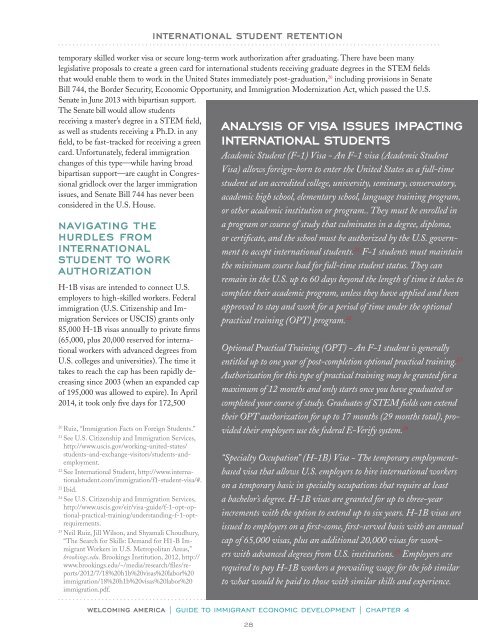IMMIGRANT
npjjbma
npjjbma
- No tags were found...
You also want an ePaper? Increase the reach of your titles
YUMPU automatically turns print PDFs into web optimized ePapers that Google loves.
INTERNATIONAL STUDENT RETENTIONtemporary skilled worker visa or secure long-term work authorization after graduating. There have been manylegislative proposals to create a green card for international students receiving graduate degrees in the STEM fieldsthat would enable them to work in the United States immediately post-graduation, 20 including provisions in SenateBill 744, the Border Security, Economic Opportunity, and Immigration Modernization Act, which passed the U.S.Senate in June 2013 with bipartisan support.The Senate bill would allow studentsreceiving a master’s degree in a STEM field,as well as students receiving a Ph.D. in anyfield, to be fast-tracked for receiving a greencard. Unfortunately, federal immigrationchanges of this type—while having broadbipartisan support—are caught in Congressionalgridlock over the larger immigrationissues, and Senate Bill 744 has never beenconsidered in the U.S. House.NAVIGATING THEHURDLES FROMINTERNATIONALSTUDENT TO WORKAUTHORIZATIONH-1B visas are intended to connect U.S.employers to high-skilled workers. Federalimmigration (U.S. Citizenship and ImmigrationServices or USCIS) grants only85,000 H-1B visas annually to private firms(65,000, plus 20,000 reserved for internationalworkers with advanced degrees fromU.S. colleges and universities). The time ittakes to reach the cap has been rapidly decreasingsince 2003 (when an expanded capof 195,000 was allowed to expire). In April2014, it took only five days for 172,50020 Ruiz, “Immigration Facts on Foreign Students.”21 See U.S. Citizenship and Immigration Services,http://www.uscis.gov/working-united-states/students-and-exchange-visitors/students-andemployment.22 See International Student, http://www.internationalstudent.com/immigration/f1-student-visa/#.23 Ibid.24 See U.S. Citizenship and Immigration Services,http://www.uscis.gov/eir/visa-guide/f-1-opt-optional-practical-training/understanding-f-1-optrequirements.25 Neil Ruiz, Jill Wilson, and Shyamali Choudhury,“The Search for Skills: Demand for H1-B ImmigrantWorkers in U.S. Metropolitan Areas,”brookings.edu. Brookings Institution, 2012, http://www.brookings.edu/~/media/research/files/reports/2012/7/18%20h1b%20visas%20labor%20immigration/18%20h1b%20visas%20labor%20immigration.pdf.ANALYSIS OF VISA ISSUES IMPACTINGINTERNATIONAL STUDENTSAcademic Student (F-1) Visa - An F-1 visa (Academic StudentVisa) allows foreign-born to enter the United States as a full-timestudent at an accredited college, university, seminary, conservatory,academic high school, elementary school, language training program,or other academic institution or program.. They must be enrolled ina program or course of study that culminates in a degree, diploma,or certificate, and the school must be authorized by the U.S. governmentto accept international students. 21 F-1 students must maintainthe minimum course load for full-time student status. They canremain in the U.S. up to 60 days beyond the length of time it takes tocomplete their academic program, unless they have applied and beenapproved to stay and work for a period of time under the optionalpractical training (OPT) program. 22Optional Practical Training (OPT) - An F-1 student is generallyentitled up to one year of post-completion optional practical training. 23Authorization for this type of practical training may be granted for amaximum of 12 months and only starts once you have graduated orcompleted your course of study. Graduates of STEM fields can extendtheir OPT authorization for up to 17 months (29 months total), providedtheir employers use the federal E-Verify system. 24“Specialty Occupation” (H-1B) Visa - The temporary employmentbasedvisa that allows U.S. employers to hire international workerson a temporary basic in specialty occupations that require at leasta bachelor’s degree. H-1B visas are granted for up to three-yearincrements with the option to extend up to six years. H-1B visas areissued to employers on a first-come, first-served basis with an annualcap of 65,000 visas, plus an additional 20,000 visas for workerswith advanced degrees from U.S. institutions. 25 Employers arerequired to pay H-1B workers a prevailing wage for the job similarto what would be paid to those with similar skills and experience.WELCOMING AMERICA | GUIDE TO <strong>IMMIGRANT</strong> ECONOMIC DEVELOPMENT | CHAPTER 428


